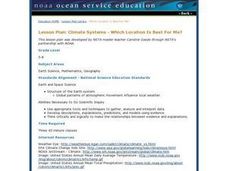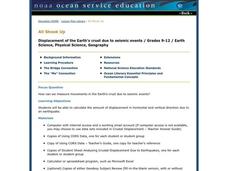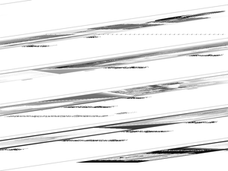Curated OER
Adaptations
Students identify what adaptation is and to research a specific mollusk. They also identify and interpret how animals get their common and scientific name and why it is Latin. Finally, students draw their shell (mollusk) and name their...
Curated OER
Moving Continents
In this moving continents worksheet, students review the different types of plate boundaries, what causes earthquakes, and where volcanoes are formed. This worksheet has 10 fill in the blank and 9 short answer questions.
Curated OER
The Water Cycle and Global Warming
Students study the flow of water in the environment. In this water cycle lesson students evaluate the consequences of changes in the water cycle using data.
Curated OER
Climate Systems - Which Location Is Best For Me?
Students study the difference between weather and climate. In this climate systems lesson students search the Internet for the parts of the Earth's system, gather climate data and complete a challenge scenario.
Curated OER
All Shook Up
Pupils calculate the amount of displacement after an earthquake. In this seismic event lesson students research the Internet, and fill out a CORS data sheet.
Curated OER
Inside-out Adaptations
Pupils describe sea stars adaptations and explain how these enable them to survive in different environments. In this animal adaptation lesson students watch a video, get into groups and create a list of characteristics of sea stars.
Curated OER
The Chemosynthetic Cafe
Students study photosynthesis and chemosynthesis. In this chemosynthetic lesson students explain the processes of these and define terms.
Curated OER
A Hydrothermal Adventure
Students analyze hydrothermal vents. In this hydrothermal vents instructional activity, students discover the effects of hydrothermal vents on tectonic plates. Students make model hydrothermal vents to understand how they form and operate.
Curated OER
When a Map Isn't A Map...
In this maps worksheet, students read about the Earth, sky, rivers and lakes, and more, and then answer short answer questions about it. Students complete 3 questions.
Curated OER
Climate
Students study zoanthids. In this science and art lesson, students use line to create texture and how to use colors to create value. Students share their beautiful mat zoanthids with the rest of the class.
Curated OER
Protist Crossword
In this protist worksheet, students complete a crossword puzzle with 34 questions about the behaviour and different types of protists.
Curated OER
Climate and Change: Fitting the Facts Together and Acting on Them
Students examine climate change. For this current events lesson, students read the provided articles "Key Facts + Key Conclusions=0?" "Oil Companies Fund Climate Change Deniers," and "Acting on Climate Change Facts." Students respond to...
Curated OER
Animal Habitats
Learners explore animal lifestyles by researching their characteristics. In this animal habitat lesson, students read the story Over in the Jungle and analyze the animal illustrations in the book. Learners create clay animal characters...
Curated OER
Production Possibilities & Opportunity Cost
In this economics worksheet, 12th graders respond to 15 multiple choice questions about production possiblities and opportunity costs.
Curated OER
Science Test-Grade 5
In this grade 5 science test worksheet, 5th graders complete a 30 question multiple choice quiz covering a variety of grade 5 concepts.
Curated OER
Hurricane Tracking
Students recognize that hurricanes are tropical storms that have a sustained wind speed greater than 74 miles per hour. In this science lesson, students plot data they observe on the National Hurricane Center Website in order to track...
Curated OER
Where's the Beach?
Students use beach profile data to analyze how erosion and sediment transport changed seashore slopes. In this geology lesson, students plot the data provided and analyze erosion patterns. They also assess coastal erosion management...
Curated OER
A Model of Three Faults
Young scholars investigate faults. In this science lesson plan, students explore the many stresses and strains in the earth's layers and research the types of faults in their state.
Curated OER
Parachute - Land and Weather
Students use different parachute activities to study weather and land patterns and formations. Tornados and hurricanes can be discussed as students make large waves (move from very high to very low) that mimmick these two weather...
Curated OER
Fallout!
Students plot the locations of fallout from two disasters that polluted much of the world's air. They plot the ash fallout from the 1980 Mt. St. Helen's eruption to see what the wind patterns in the United States look like overall. Next...
Curated OER
Big Apple, Here We Come
Students role play the role of immigrants coming to America for the first time. They complete an imaginary trip with their family and must rent a car and make seven stops along the way. They calculate distances and use maps to...
Curated OER
Fort Clatsop: The Corps of Discovery's Winter at Fort Clatsop
High schoolers investigate the Lewis and Clark expedition and how it helped to shape American expansion during its early history. Students reflect upon the period of history and its implications for America.
Curated OER
Air Masses
Students examine the physical characteristics of several types of air masses to discover how air masses can be identified and defined by their temperature and moisture content.
Curated OER
The Sine Function
Students explore the concept of the sine function. In this sine function activity, students use a plexiglass sine wave generator to visualize the sine function. Students use a computer program/calculator to adjust aspects of the sine...
























